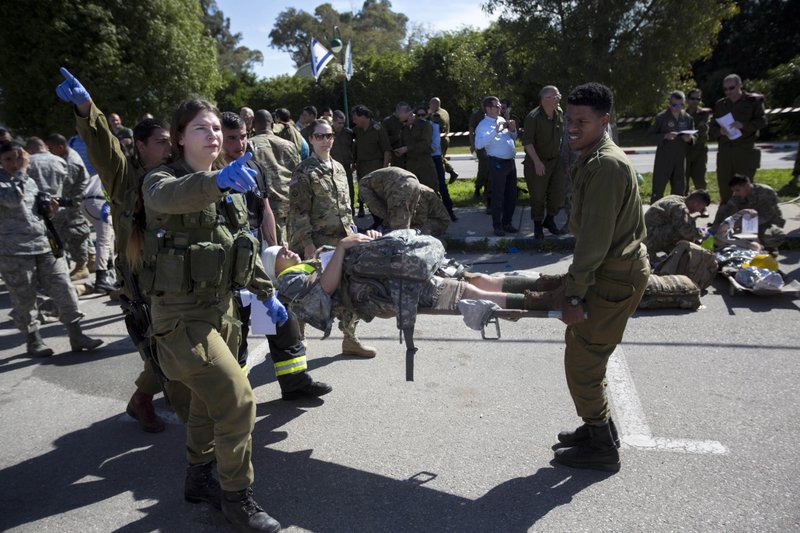JERUSALEM -- Israel is drawing up contingency plans to evacuate up to 250,000 civilians from border communities to protect them from attacks from Hamas, Hezbollah or other Islamic militant groups.
The mass evacuations would be the biggest in Israel's history, part of a bigger plan in which the army works with municipalities to keep civilians safe.
All sides have been preparing in case a new round of warfare breaks out, although Hezbollah, a Lebanon-based group sworn to Israel's destruction, currently is tied down in Syria's civil war, fighting in support of President Bashar Assad. It also comes amid an uptick in tensions between Israel, Syria and Hezbollah.
Each side has warned that a new conflict would be worse than previous ones. Hezbollah fired more than 4,000 rockets on Israeli communities in a 2006 war, while Israel bombarded militant targets in southern Lebanon. The month of fighting killed an estimated 1,200 Lebanese, most of them civilians, as well as 44 Israeli civilians and 121 Israeli soldiers.
In 2014, 50 days of fighting between Israel and Gaza's Islamic militant Hamas rulers killed an estimated 2,100 Palestinians, six Israeli civilians and 66 Israeli soldiers. There was widespread devastation in Gaza and thousands of rockets and mortar rounds fired by Hamas and other Islamic militants at Israeli towns and cities.
Israel says Hezbollah and Hamas have rebuilt large arsenals capable of hitting the entire country. Elements of the evacuation plan, code-named Safe Distance, were disclosed by a senior Israeli officer in an interview.
"In 2017, all of Israel is under threat," said Col. Itzik Bar of the military's Homefront Command. Preparations are underway for Israel to deal with "very high amounts" of incoming fire, he said.
Bar pointed out that Hezbollah has gained battle experience from fighting alongside Assad's forces and that Hassan Nasrallah, the Shiite group's chief, recently increased his rhetoric about attacking Israel.
The idea is to "remove the threat by not having civilians there," Bar said. "We want a meeting of army and Hezbollah forces and not civilians with Hezbollah forces."
The evacuation plan would apply mainly to communities adjacent to the borders, he said.
"In places where we understand there is a great danger to civilians, for example, where we won't be able to supply defenses or supply deterrence ... we will evacuate," Bar said.
Evacuees would be housed in existing infrastructure, including hotels, schools and Kibbutz guesthouses, he said.
The scope of evacuations would depend on the situation, but all told, the plans cover up to 250,000 people who would be moved to safety if there were a conflict on multiple fronts, he said. Israel has a population of about 8.5 million.
Small core groups would stay behind in evacuated areas to maintain vital infrastructure and ensure that communities "function the day after the fighting," he said.
Another senior security official, speaking on condition of anonymity in line with protocol, said the idea resulted from lessons learned in the 2014 Gaza war, in which communities were not evacuated but residents eventually left on their own.
Tens of thousands of Israelis left their homes near the Gaza border as the fighting dragged on, turning some areas into ghost towns. The exodus was sparked by Palestinian shelling, along with the fear of heavily armed Gaza militants infiltrating Israel through tunnels.
Border communities vulnerable to mortar fire are the most in danger, he said.
Israel's Iron Dome defense system was used in the 2014 war, ensuring a decisive protective edge from short-range rockets fired from Gaza. But the security official said there were not enough of the defensive systems to cover attacks on multiple fronts.
He said Hezbollah has significantly built up its weapons stockpile since the 2006 war and has upgraded its arsenal to about 150,000 missiles.
Israel has made it clear it will act to prevent Hezbollah from getting advanced munitions and is widely believed to have carried out several airstrikes in recent years on weapons convoys destined for the militant group. On Friday, it made a rare admission of such a strike after Syria fired missiles at its jets.
However, the official said Israel fears that some advanced weapons like surface-to-sea weapons or anti-aircraft missiles might already have reached Hezbollah.
Israel, meanwhile, has been building up its missile defenses. A system called David's Sling to intercept medium-range missiles from Hezbollah is to become operational in early April. That would mark the completion of a multilayer missile defense system that includes Iron Dome and Arrow, designed to intercept long-range ballistic missiles -- of the type possessed by Iran -- high in the stratosphere.
The military also has vastly improved its early-warning systems, according to Bar, the Israeli colonel.
A Section on 03/22/2017
